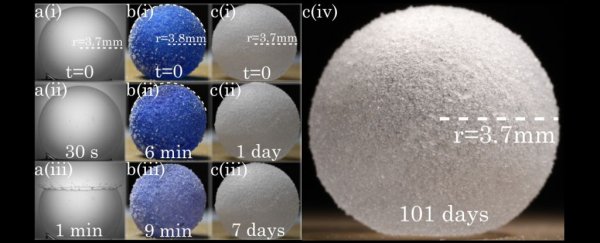When you think of the word "ephemeral", many people will immediately conjure up the image of a soap bubble: delicate, gorgeous, and gone in a blink (or maybe a few).
Now a team of physicists led by Aymeric Roux of the University of Lille in France has defied this cliché, creating a bubble that maintained its shape for a record 465 days.
While perhaps not as pretty as the shimmering, shifting iridescence of soap bubbles, the team's creation, made with the help of glycerin (also known as glycerol) could help scientists develop new materials, such as foams and films.
"We show that covering a bubble water shell with microparticles inhibits gravity-induced drainage and that further adding glycerol leads to a stable state, wherein the evaporation of water is counterbalanced by the hygroscopicity of glycerol, which absorbs water molecules contained in ambient air," they write in their paper.
"This results in bubbles which can keep their integrity in a standard atmosphere for more than one year, with no significant evolution of their radius."
Generally, there are three things that contribute to the short lifespan of a bubble in an atmospheric setting. Gravity can drain material from the bubble membrane; evaporation can diminish the amount of liquid present; and the very presence of tiny nuclei in the air can destabilize the whole thing.
To see if they could expand the lifespan of the bubble, the team turned to a recent invention called "gas marbles". These are gas bubbles whose shells are made of liquid and partially-wetting particles, surrounded by ambient gas.
The particles, usually a kind of polymer or plastic, allow the marbles to maintain structural integrity even when touched.
Roux and colleagues wanted to see if they could make a gas marble remain intact for a long span of time, so they experimented with different kinds of bubbles. Soap bubbles were included as a point of comparison, and the team also constructed gas marbles of nylon particles and water, and nylon particles and a mix of water and glycerol.
The soap bubbles, naturally, did not last long at all – no longer than a minute. The water-based gas marbles fared better, surviving for durations between 6 and 60 minutes.
The glycerol-water marbles, on the other hand, survived a spectacularly long time, longer than 101 days, with the longest lasting a whopping 465 days.
This, the team notes, is the result of adding glycerol. This substance is a hygroscopic material – that is, it readily and easily absorbs moisture from its surrounding environment, or the atmosphere.
The nylon particles prevent the bubble membrane from draining away gravitationally; the glycerol, absorbing moisture from the atmosphere, replenishes that which evaporates away. As these two phenomena are neutralized, the bubble also becomes impervious to being popped by those pesky gas nuclei kicking about in the air.
This is what allowed the bubble to maintain its structure for such long periods.
"We have shown that air bubbles keeping their integrity for more than one year can be produced in a simple way by replacing surfactants by partially-wetting particles and water by a water/glycerol mixture," the researchers write.
The team also constructed a detailed model of the material's properties, and used that model to create other structures, such as a pyramid stretched over a metal frame, by dipping it in the material and slowly lifting it out. At least one of the pyramids the team created survived for 378 days at the time they wrote the paper.
These remarkable achievements suggest that an entire new class of objects could be created from this mix of materials, the researchers note – with physical and chemical properties that we are yet to discover.
The research has been published in Physical Review Fluids.
